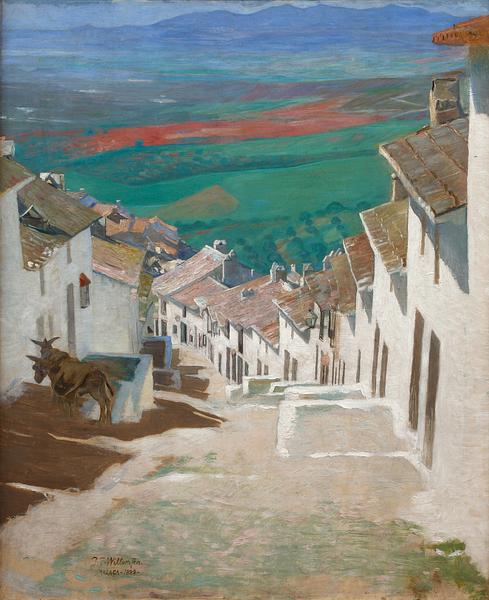In 1888, J.F. Willumsen, who was 26 at the time, set out on his first trip abroad, which first took him to Paris and from there on to Spain. Extending across eight months, the journey had a crucial impact on Willumsen and his artistic development.
‘I reached the first artistic peak of my youth and understood that the old art meant nothing to me in light of my new communion with nature. only nature could teach me to paint. In Alora, the artist in me matured. I found myself and shaped the outlook on colour and overall idiom to which I would remain true throughout my life, even though I always continued to explore new possibilities, new paths.’[1]Street in Alora is one of the first pictures which see Willumsen painting by strong daylight, imbuing the scene with a distinctive intensity of light that affects the colours, making them bold and rich in contrast. ‘
The countryside of the South spoke to me in colours,’[2] Willumsen recollected several years after his visit to the small mountain town of Alora, not far from Málaga, where he found this scene with its peculiar perspective. Willumsen chose an elevated point of view from which the steep, almost dizzying downward course of the street is marked out by the descending lines of architecture. The background with its lush, expansive landscape and the mountain range in the distance raises the terrain again – all the way up to the picture frame.
Willumsen considered the painting among the best works from his journey: ‘
The most consistent, complete and also the most successful picture I painted in Alora was the street going downwards. Here, I had found a new subject. I have never seen another painter paint anything like this, neither before nor since. It really represents a large hole, and a hole will deter any painter, requiring him to paint something which is “nothing”.’[3]Today,
Street in Alora merits attention as one of Willumsen’s early masterpieces. In the 1950s, C.L. David acquired it for his collection, which today comprises a total of nineteen works by Willumsen’s hand.
Inv. no. B 453
Published in:
Theodore Reff: Salon of the “Nationale” 1890, New York 1981, no. 897, p. 27;
Willumsen udstillingen, arrangeret af Den frie Udstilling i Anledningen af Kunstnerens 60-Aars Fødselsdag, København 1923, 2. ed., cat. 40;
Sigurd Schultz: J.F. Willumsen. En Fortolkning af hans Personlighed og Idéerne i hans Livsværk, København 1948, p. 31;
Erik Zahle: ”Malerisamlingens vækst” in C.L. Davids Samling, Tredje del, København 1958, pp. 127, 158-159;
J.F Willumsen: Mine Erindringer fortalt til Ernst Mentze med biografiske Oplysninger, Noter og Kommentarer, København 1953, pp. 49, 53, 62;
Ernst Mentze: J.F. Willumsen, København 1957, pp. 17-19, 23;
C.L. David: C.L. Davids Samling, København 1960, p. 23;
Roald Nasgaard: Willumsen and symbolist art 1888-1910, Diss. New York University 1973, printed 1996, fig. 21, pp. 72-73, 77, 112;
Grete Zahle: Dansk Kunst 1885-1915, Kunstforeningen, København 1976, cat. 58, p. 56;
Leila Krogh in Kjeld von Folsach and Nana Lund (eds.): Dansk kunst i Davids Samling – fra Philipsen til Saxbo, København 1995, cat. 14, pp. 72-73;
Lise Buurgård: J.F. Willumsen: bjerget, kvinden, selvet, 2. ed., Odense 1999, fig. 22, pp. 33-34, 37;
Henrik Wivel: J.F. Willumsen, København 2005, fig. 6, pp. 12-13;
Ulla Hjort: J.F. Willumsen i Europa, J.F. Willumsens Museum, Frederikssund 2006, fig. 25, pp. 45-46;
Leila Krogh: J.F. Willumsen: Over grænser, Ordrupgaard, København 2006, cat. 4, pp. 55-56;
Henrik Wivel: Vejen. Et motiv i kunsten gennem 400 år, Nivaagaards Malerisamling, Nivå 2014, cat. 26, p. 61-64;
Peder Rasmussen: Familie på træben. Om J.F. Willumsens Familievase, København 2016, pp. 26-27;
Henrik Wivel: Jeg er en anden: en biografi om J.F. Willumsen, København 2024, Vol. 1, 1863-1914, fig. 47, pp. 88-89 and 94;
Ingo Borges and Thorsten Sadowsky (eds.): Willumsen: Generalprobe, Schloss Gottorf, Schleswig 2024, cat. 10, p. 53:
